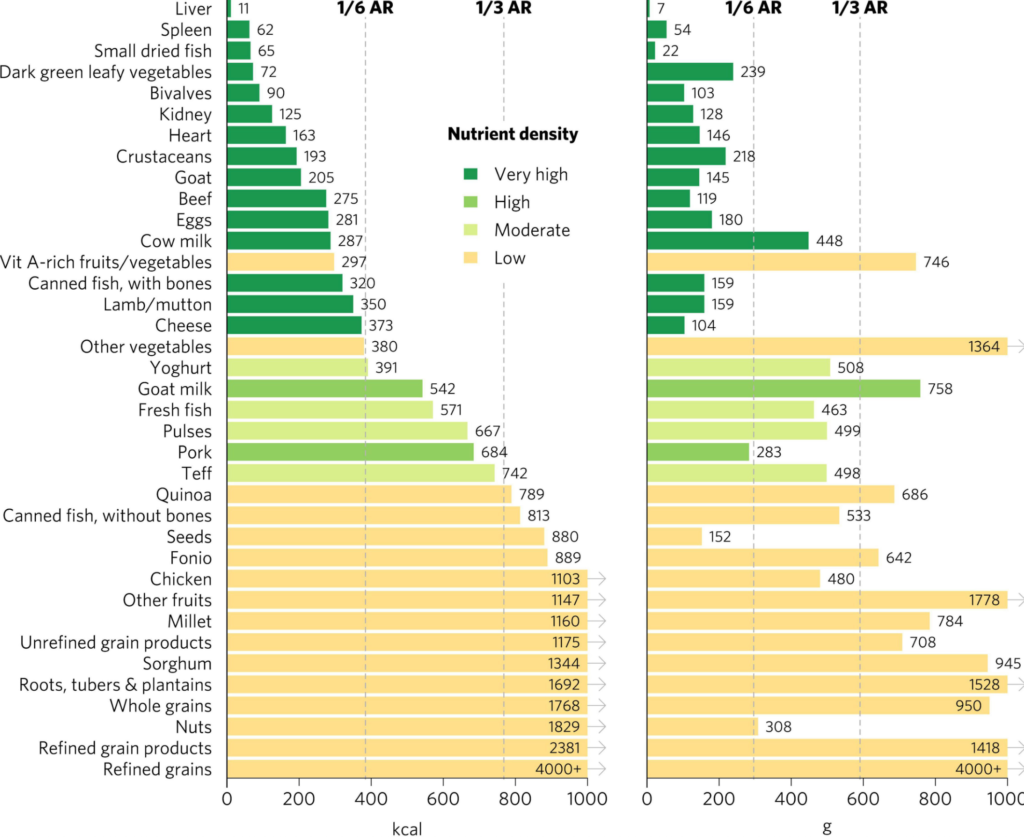
Why Organ Meats Are Making a Comeback
Page Contents:
Organ meats have been a staple in traditional diets for thousands of years. They are still regularly consumed in many countries today and were even part of our diets in the U.S. and other industrialized countries until relatively recently.
Your grandparents may have eaten liver and onions growing up or taken cod liver oil when they were sick. Then, just after World War II, organ meats largely disappeared from the American diet.
In this article, you’ll learn why that was a mistake and why it’s good news that organ meats are now making a comeback. You’ll discover that organ meats are, ounce for ounce, the most nutrient-dense foods we can eat, and I’ll show you how to incorporate these traditional superfoods into your diet—or supplement with them if you just can’t bring yourself to eat organs.
The fascinating history of organ meat consumption
Today, when you go to the meat section in the grocery store, you’re likely to see a wide range of cuts of muscle meat: steaks, chops, loin, burgers, chicken breast, etc. The same is true when you go out to a restaurant. You’ll rarely see liver or other organ meats behind the meat counter or on a menu.
But this predominance of muscle meats is a relatively recent trend. Organ meats, which are also known as “offal”, include heart, liver, kidney, pancreas, spleen, tongue, brain, tripe, thymus, gallbladder, and other internal tissues. Our ancestors prized these foods and were strongly favored over the muscle meats that have become common fare today.
For example, in his book Nutrition and Physical Degeneration, the American dentist Weston A. Price noted that, after a successful hunt, indigenous North Americans of the Canadian Rockies gave the muscle meat to the dogs and saved the offal for themselves. (1) Price also tells the story of an early American settler who went blind from vitamin A deficiency while crossing the Rocky Mountains and was assisted by native people in that region who fed him fish eyes (which we now know to be a rich source of vitamin A.)
Traditional Tartars from the Crimea and other regions consumed a wide range of organ meat, including lungs, kidneys, liver, a dish of brains, and tongue. (2)
Australian Aboriginal people prized the brain and liver of the wallaby, kangaroo, small animals, and rodents they ate. (3)
The traditional Inuit of the Arctic were known to eat the skin, organs, and fat of both caribou and fish and mammals from the sea. (4)
Even today, there are many examples around the world of cultures that continue to value and consume offal:
- Costa Ricans serve pork shanks cooked with liver, kidney, ears, cheek, brain, and heart and fried pieces of pork belly called chicharrónes. (5)
- In Romania, piftie, which consists of pig tails, feet, and ears, is spiced with garlic and served in bone gelatin. (6)
- Kizdirma, a popular dish in Eastern Europe, is made from fresh lamb organs, including heart, kidney, and liver. (7)
Despite the lack of scientific instruments and measurement techniques, these traditional cultures knew from experience that organ meats were far more nutritious than muscle meats.
And today, modern science has confirmed this.
Modern research on organ meats confirms their superior nutritional value
A lot of research has been published over the past few years on the relative nutrient density of common foods, in an attempt to improve diet quality and reduce the burden of micronutrient deficiencies and malnutrition around the world.
Nutrient density is typically defined as the concentration of micronutrients and amino acids, the building blocks of proteins, in a given food. While carbohydrates and fats are important, these macronutrients can be partially synthesized by the body for a limited amount of time if dietary intake has been insufficient. (A major exception: the essential omega-6 and omega-3 fatty acids, which we can only get through food.)
Previous studies in this field have shown that organ meats are, ounce-for-ounce, the most nutrient-dense foods we can eat. A paper by Matthieu Maillot and colleagues published in 2007 looked at seven major food groups and 25 subgroups, characterizing the nutrient density of these foods based on the presence of 23 qualifying nutrients. The table below displays the results; each food was given a numbered score for reference, with the highest numbers corresponding to the highest levels of nutrient density. (8)
| Food Group | Nutrient Density Score |
|---|---|
| Meat | |
| Organ meats | 754 |
| Shellfish | 643 |
| Fatty fish | 622 |
| Lean fish | 375 |
| Eggs | 212 |
| Poultry | 168 |
| Red meats | 147 |
| Deli meats (processed) | 120 |
| Fruits and Vegetables | |
| Vegetables | 352 |
| Fruits | 134 |
| Nuts | 120 |
| Dried fruits | 85 |
| Dairy Products | |
| Milk | 138 |
| Yogurt | 119 |
| Cheese | 101 |
| Starches and Grains | |
| Legumes | 156 |
| Whole grains | 83 |
| Potatoes | 75 |
| Refined grains | 40 |
| Added Fats | |
| Vegetable fats | 80 |
| Animal fats | 25 |
The latest and one of the most comprehensive nutrient density studies appeared in the journal Frontiers of Nutrition in March of 2022. (9) The primary author was Ty Beal, a research advisor on the Knowledge Leadership team at the Global Alliance for Improved Nutrition. Beal and his co-author Flaminia Ortenzi sought to identify the foods which are highest in iron, zinc, folate, vitamin A, calcium, and vitamin B12 since these are the most common micronutrient deficiencies worldwide—including in industrialized countries like the United States.
Beal & Ortenzi’s paper was unique compared to previous studies in that it considered the important role of bioavailability.
“Bioavailability” refers to the portion of a nutrient that is absorbed in the digestive tract and released into the bloodstream for the body’s use. The amount of bioavailable nutrients in a portion of food is almost always lower than the number of nutrients the food contains. For example, the bioavailability of calcium from spinach is only 5 percent. Of the 115 mg of calcium present in a serving of spinach, only 6 mg is absorbed. This means you’d have to consume 16 cups of spinach to get the same amount of bioavailable calcium in one glass of milk! (10)
Like Maillot, Beal & Ortenzi found that organ meats were the most nutrient-dense foods available. In fact, organs comprised four of the top seven most nutrient-dense foods on their list!

The incredible nutritional benefits of organ meats
Collectively, both ancestral practices and modern research tell us that organ meats are the most nutrient-dense foods we can eat. But which nutrients, in particular, are most highly represented in offal?
Organ meats are rich in essential nutrients that support cellular function, such as vitamins A & E, B complex, and heme iron.
For example:
- Liver is one of the highest sources of bioavailable retinol (the active form of vitamin A), vitamin B12, iron, zinc, and copper
- Spleen is the highest known source of bioavailable iron
- Heart is the richest source of bioavailable CoQ10, a critical antioxidant
- Kidney is the third-richest source (behind liver and clams) of B12
Organ meats are some of the best sources of amino acids like carnosine, which helps maintain normal pH in muscles, and taurine, which reduces muscle damage and improves recovery after exercise. (11, 12) Perhaps this is why liver and other organ meats have historically been consumed by athletes to improve their performance!
Organs are also full of enzymes and biopeptides that perform important regulatory functions in the body, including improvements in intestinal health, nutrient intake, feed conversion efficiency, mineral bioavailability, and immune function. (13)
Finally, organ meats are higher in protein by weight than muscle meats, and on average, they have a more favorable ratio of omega-3-to-omega-6 fatty acids.
How organ meats may extend lifespan
Some studies suggest that diets high in methionine, an amino acid that is abundant in muscle meats and other lean proteins, may increase the risk of cancer and reduce lifespan. (14, 15)
However, this is only true if high methionine intake is not balanced with adequate intake of complementary nutrients like the amino acid glycine and nutrients like B12, folate, betaine, and choline. (16) These nutrients offset the potential downsides of high methionine intake—and are found predominantly in the “odd bits” of the animal, including organs, connective tissues, skin, and bones.
The 5 best organs to consume
Liver
When it comes to discussions of organ meat, liver is always at the top of the list—and for good reason. It contains a variety of vitamins and minerals, including vitamins A, E, B1, B3, B6, biotin, and folate, along with copper, heme iron, zinc, and omega-3 fatty acids. These nutrients play a vital role in cellular energy metabolism, DNA synthesis, oxygen transport, and neurotransmitter synthesis and function.
A single, 3-ounce serving of liver would meet the recommended dietary allowance (RDA) for retinol (the active form of vitamin A) for an entire week. To get the same amount from plant foods, you’d have to eat two cups of carrots, one cup of sweet potatoes, or two cups of kale every day!
Liver is also the second-richest source of vitamin B12 and one of the highest sources of iron. These nutrients play critical roles in cellular energy production, DNA synthesis, and oxygen deliverability, among many other functions.
This likely explains why doctors in the early 20th century referred to liver as the “anti-fatigue” factor prior to it falling out of favor in the U.S. diet.
Spleen
Spleen is perhaps best known for being an incredibly rich source of bioavailable iron.
Why is bioavailability so important with iron in particular? The bioavailability of the iron in plant foods (nonheme iron) is much lower than in animal foods (heme iron). Plant-based forms of iron are also inhibited by other commonly consumed substances, such as coffee, tea, fiber, and Ca supplements. This explains why vegetarian diets have been shown to reduce nonheme iron absorption by 70 percent and total iron absorption by 85 percent. (17, 18)
I’ve used spleen in my clinic—either as a food or as a supplement—with my most severely iron-deficient patients, with incredible results. In fact, I’ve had patients that didn’t respond to iron transfusions but were able to restore normal iron levels simply by eating (or taking) both liver and spleen.
Heart
Heart is often referred to as a “gateway” organ meat because it is technically a muscle, and it has a texture and taste that is closest to other muscle meats.
That said, heart is one of the highest dietary sources of CoQ10, which is a critical antioxidant that protects our cardiovascular system and plays an important role in cellular energy production. (19)
Heart is also a rich source of collagen and the amino acid glycine, both of which help to balance methionine intake, reduce the risk of cancer that is associated with high methionine diets, and support connective tissue health.
Kidney
After liver and clams, kidney is the highest dietary source of vitamin B12–with a single serving providing 1118% of the RDA! (20) Kidney is also a good source of vitamin D, vitamin B12, niacin, selenium, iron, zinc, copper, potassium, and phosphorus.
Kidney is also a good source of the rare amino acid L-Ergothioneine, which has been shown to reduce oxidative damage in the kidneys and support kidney health. (21)
Pancreas
Pancreas is a rich source of B12, vitamin B12, and vitamin B5 (aka pantothenic acid). Vitamin B5 supports healthy cholesterol levels and skin. Low B5 can lead to fatigue, insomnia, mood issues, neuropathy, and a higher risk of respiratory tract infections. (22)
The pancreas secretes digestive enzymes and produces hormones that regulate blood sugar. In traditional cultures, pancreas is valued for this function.
What about the claim that we shouldn’t eat liver because it stores toxins?
A popular objection to eating liver is the belief that it is a storage organ for toxins in the body. While it is true that one of the liver’s role is to neutralize toxins (such as drugs, chemical agents and poisons), it does not store these toxins. Toxins the body cannot eliminate are likely to accumulate in the body’s fatty tissues and nervous systems.
On the other hand, the liver is a storage organ for many important nutrients, such as vitamins A, D, E, K, B9 (folate), and B12, and minerals such as copper and iron. These nutrients provide the body with some of the tools it needs to get rid of toxins.
This means that consuming liver is more likely to help the body with detoxification than cause any accumulation of toxins.
The importance of grass-fed, grass-finished sources
It’s important to eat organ meats from animals that have been raised on fresh pasture without hormones, antibiotics, or commercial feed containing genetically engineered ingredients.
Beef from cattle on grass-based diets has a better fatty-acid and antioxidant composition than beef from feedlot cattle. (23) A study published in 2020 found that people who ate primarily grass-fed beef had lower levels of myristic and palmitic acid, increased conjugated linolenic acid (CLA) and trans-vaccenic acid (TVA). This suggests that eating grass-fed meat and organ meat improves the composition of dietary fatty acids. (24)
How to get the benefits of organ meat
The most obvious way to get the benefits of organ meats is to eat them! But this isn’t always easy. Organ meats have a distinct flavor and different texture than muscle meats, which many people living in the modern world are not accustomed to.
Heart is often the easiest organ for people to begin eating since it is technically a muscle and its flavor and texture are closest to other muscle meats. From there, liver is probably the next best choice, for two reasons: it is more readily available at local grocery stores than other organs, and it’s easier to find good recipes and techniques for preparing it. Once you’ve mastered the art of cooking liver, you can move on to exploring kidney, pancreas, and spleen recipes.
Here are a few general tips for how to prepare each organ.
Liver
For those that are lucky enough to enjoy the taste and texture of liver, the classic “liver and onions” dish is an easy way to get started. Otherwise, there are several ways to reduce or mask the strong taste of liver:
- Soak it in milk overnight
- Chop it up finely and add to spiced ground beef or other meat dishes (e.g. meatloaf, meatballs, etc.)
- Make liver paté
- Wrap it in bacon
Another option is to eat liver raw, as a supplement. You can chop it into small, pill-size pieces, and then freeze it for at least two weeks to kill any potential pathogens that might be present in the raw liver. Then you just swallow about one-half ounce of the frozen liver “pills”. This is equivalent to eating one three-ounce serving a week.
Heart
As noted above, beef heart has a fairly mild taste and a familiar texture to muscle meat. You can cook it like a roast. Hearts from other animals are also tasty. Try adding chicken or turkey hearts to dishes like stir-fries or meatballs.
Pancreas
The easiest way to eat pancreas is in the form of “sweetbreads”. In this context, sweetbread is a culinary term that refers to a mixture of different organs or glands, which usually includes the pancreas, thymus, and sometimes the brain.
In Mexico, sweetbread tacos are a popular dish. Check out this recipe and give it a try!
Kidneys
Admittedly, kidneys have a strong flavor that many people struggle with, so this is not a great “starter” organ meat. That said, kidney dishes are popular in some cultures, and they can be quite tender when prepared properly.
This recipe for veal kidneys from Chef Harold Moore of Bistro Pierre Lapin is a great starting place for those that want to give kidney a try.
Spleen
There is a specific procedure to follow when preparing beef spleen, in order to make it palatable:
- Trim the outer skin from the spleen with a sharp knife
- Rinse well
- Simmer in water in a saucepan for two to three hours
- Cut into small chunks and add to other dishes
As with liver and the other organs, it’s probably easiest to add spleen to other meat dishes like ground beef, meatloaf, or meatballs, until you’ve fully acquired the taste.
Supplementing with organ meats if you don’t care to eat them
Another way to benefit from organ meats is to supplement with them. This is a good option for those who don’t care for the taste or texture of organ meats, or who don’t have the time or interest to prepare them properly.
There are several important things to consider when choosing an organ meat supplement:
- It should contain a blend of the most nutritious organs, including liver, heart, kidney, spleen, and pancreas
- It should be sourced from 100% grass-fed, grass-finished cattle
- The daily serving size should be roughly equivalent to eating one serving of organ meats a week
- The cattle should never receive antibiotics, growth hormones, stimulants, or commercial feed with GMOs
- It should have no artificial or synthetic ingredients and no artificial flavors, colors, or chemical preservatives
- It should be gluten-free, dairy-free, soy-free, and GMO-free
I hope this article convinced you of the benefits of eating or supplementing with organ meats and inspires you to get started! Eating a nutrient-dense diet is one of the most important steps we can take toward improving our health, and organ meats are the most nutrient-dense foods we can eat. Good luck!






